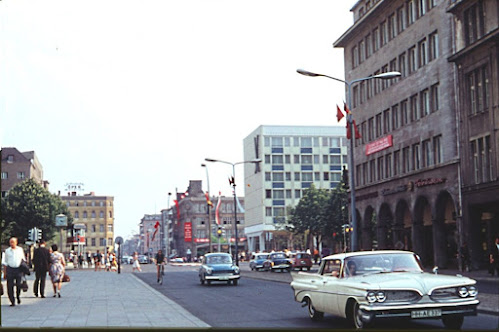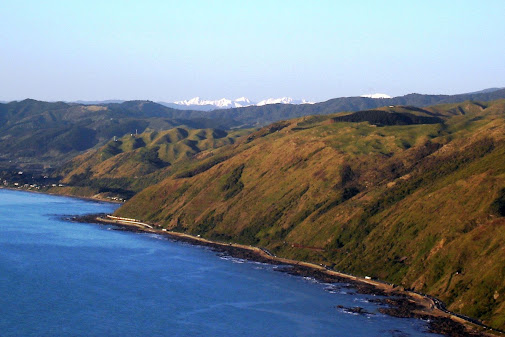Monday, October 31, 2022
Sunday, October 30, 2022
Italian 4-6-2 steam loco painting
By J. Craig Thorpe. "This painting was originally published on the Republic of the Marshall Islands First Day Cover for the 55c Italian 4-6-2 stamp issued 23 August 1996. From 1928 to 1933, the Italian State Railway or Ferrovie dello Stato (FS) constructed the Group 691s, the largest Italian passenger locomotives ever built Group 691s were also among the last Italian steam engines constructed, since none were built for domestic use after the 1930s. Group 691 boilers were interchangeable with those of Group 746 freight engines and the sandbox was located around the steam dome -- a common feature of Italian locomotives. Though powerful, a 19 ton axle-load limited the 691's range to a few main lines including Venice to Rome and Venice to Udine. Although Italy was among the first countries to use diesel and electric locomotives due in part to abundant hydro power and Italy's proximity to oil supplies -- steam locomotives continued to play an important role in that country well into the 1970s. Only 33 Group 691s were built and their longevity is a testimony to the simple and efficient design."
Saturday, October 29, 2022
Arrow commuter service launched in California
San Bernardino County Transportation Authority’s Arrow passenger service has launched, providing an hourly link between San Bernardino-Downtown station on the Los Angeles region’s Metrolink commuter network and the University of Redlands.
Revenue services on the 14·5 km [8.8 mile] line began on October 24 following a ribbon cutting on October 21. Celebrations on October 29 will include balloons, face painting, a taco truck and giveaways.The line has five stations, at San Bernardino-Downtown, San Bernardino-Tippecanoe, Redlands-ESRI, Redlands-Downtown and the terminus at the University of Redlands.
‘By extending passenger rail service to Redlands with new, modern and eco-friendly trains, the agencies are fulfilling commitments to not only provide southern California residents with greater regional rail connectivity, but also meet California’s aggressive climate-improvement goals’, said Metrolink Board Vice-Chair and SBCTA board member Larry McCallon.
There will initially be 42 weekday trains running every 30 min during peak hours and every 60 min off peak between 05.30 and 21.00, plus services at weekends.
There are connections to Metrolink’s San Bernardino Line and Inland Empire-Orange County Line at San Bernardino-Downtown, and one Metrolink Express round trip each weekday between Redlands-Downtown and LA Union station, operated using loco hauled stock. The line can also accommodate freight trains.
There will initially be 42 weekday trains running every 30 min during peak hours and every 60 min off peak between 05.30 and 21.00, plus services at weekends.
There are connections to Metrolink’s San Bernardino Line and Inland Empire-Orange County Line at San Bernardino-Downtown, and one Metrolink Express round trip each weekday between Redlands-Downtown and LA Union station, operated using loco hauled stock. The line can also accommodate freight trains.
Infrastructure
Developed by the San Bernardino County Transportation Authority to support population and employment growth in the area 100 km east of central Los Angeles, the Arrow service uses a former AT&SF freight line owned by San Bernardino Associated Governments.
The $359·7m cost of the project was funded with $86m from the federal government, $164·6m from the state of California and $109·1m from local sources.
In 2011 HDR was award an 18-month contract to provide preliminary engineering services. Utility relocation began in 2018, and the following year Flatiron Construction Corp was awarded the $154m main works contract which covered an extensive rebuild of the freight line including five bridges and 24 level crossings. The line is largely single-track with a 3 km [1.8 mile] double-track dynamic passing loop in the middle of the route.
The $359·7m cost of the project was funded with $86m from the federal government, $164·6m from the state of California and $109·1m from local sources.
In 2011 HDR was award an 18-month contract to provide preliminary engineering services. Utility relocation began in 2018, and the following year Flatiron Construction Corp was awarded the $154m main works contract which covered an extensive rebuild of the freight line including five bridges and 24 level crossings. The line is largely single-track with a 3 km [1.8 mile] double-track dynamic passing loop in the middle of the route.
Rolling stock
Built at the company’s Salt Lake City factory, the DMUs meet EPA Tier 4 emissions standards. They are fitted with PTC and meet the Federal Railroad Administration’s Alternative Vehicle Technology regulations, allowing mixed operation with freight trains.
The 48·5 m long trains have two passenger cars and a central power module, with 116 seats and standing room for 118 passengers. Arrow services operate at up to 70 km/h [42 mph], although the design is capable of 160 km/h [100 mph].
The 48·5 m long trains have two passenger cars and a central power module, with 116 seats and standing room for 118 passengers. Arrow services operate at up to 70 km/h [42 mph], although the design is capable of 160 km/h [100 mph].
Friday, October 28, 2022
Thursday, October 27, 2022
English railway battery powered shunter (switcher) from 1917
The engine was designed to be able to contend with the narrow internal railway of Thomas Bolton & Sons Ltd. Copper Works; the locomotive worked at Bolton’s Oakamoor Works for all of its working life, from 1917 to 1963.
When No. 1 started work in 1917 it replaced three horses, although two horses were still used and stabled at Bolton’s Copper Works until about 1941. On one charge, No. 1 could run for up to six hours and haul a load of more than four times its weight at 11 mph [18 km/h].
Wednesday, October 26, 2022
2018 Holden Commodore VF2 SV6 3.6P/6AT
With NZ Police deciding to change from their traditional vehicle supplier -- Holden -- to Skoda, the last 5 Holdens in its fleet were donated to museums in the country. This one, retired in May 2022, is at the large Southward Car Museum in Otaihanga between Paraparaumu and Waikanae on the Kapiti Coast.
Tuesday, October 25, 2022
Santa Fe 4-8-4 in California
One of the 30 of Santa Fe's 2900 class 4-8-4, 2928, in passenger train helper service over Cajon Pass. Photo taken at Summit on 19 October 1952 by an unknown photographer. The class was built by Baldwin in 1944. More info
1959 Pontiac Bonneville on Unter den Linden, East Berlin, 1966
With the typical white on red banners with communist slogans visible. The car must have belonged to a visiting Westerner.
cars outside the Arcade Theatre circa 1938
An artwork entitled "Saturday Night At The Movies" by Lanis Brent Whitsel, webpage
Monday, October 24, 2022
Sunday, October 23, 2022
Saturday, October 22, 2022
first run of the 'Inlander' train set in Queensland, Australia, February 1953
What looks like a colorized photo of the first Air-Conditioned passenger car set in Queensland service on a trial run to Toowoomba carrying invited guests on Sunday 1 February 1953. Here it crosses Swansons Bridge in the Toowoomba Range.
Friday, October 21, 2022
1938 Hendrickson truck and trailer
"In 1926, Hendrickson introduced the first tandem truck suspension, which mounted the axles on each end of an equalizing beam. This unique 'walking beam' design distributed the truck's load evenly between the two rear axles, which improved traction and greatly reduced the effects of bumps and potholes in the road. The walking beam soon gained widespread acceptance among the industry's new 6x4 'six wheeler' trucks, which allowed more payload.
"In 1978, The Boler Company, whose holdings included manufacturers of leaf springs and metal bumpers, purchased Hendrickson. In the years that followed, Hendrickson would expand into or acquire additional businesses in related areas—trailer suspension systems, auxiliary axle systems, springs, metal bumpers, and other heavy-duty components."
experimental bush tramway tractor, Karapoti Gorge, NZ, circa 1920
Thursday, October 20, 2022
Wednesday, October 19, 2022
Helsinki horse tram of 1890
Tram tracks involving steel wheels on steel rails have much less friction than wood or rubber wheels on paved or unpaved roads; but there are nevertheless limits on the loads that horses can haul up gradients: electric motors had to take over and they did within a few years.

















































